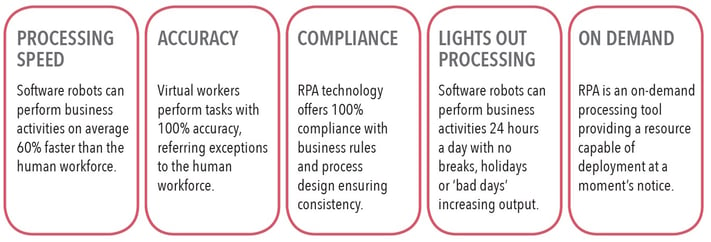
Global headlines often focus on cost savings to grab attention.
In a similar vain to describing what RPA is, or how RPA works, discussing the benefits of RPA requires a detailed explanation.
Cost reduction is an obvious benefit, but the true benefits of RPA extend beyond the narrow focus of cost control providing organisations with a lever to increase speed and agility and improve the customer experience. These benefits are in conjunction with broad improvements to operating performance including increased output, processing accuracy and quality, compliance and risk reduction. The three key benefits of RPA are explained below, or you can find out more about these and RPA in the Comprehensive Guide to RPA.
1. Increasing Speed and Agility
There are two ways in which RPA helps organisations to increase speed and agility.
RPA provides organisations with a flexible resource that can easily respond to fluctuations in demand.
Take for example a marketing campaign that is “too” successful and drives an unanticipated spike in demand. The organisation is not resourced to respond to such increases negatively impacting response times and service quality. In these situations, ‘virtual workers’ can be instantly re-assigned to absorb demand fluctuations and in some cases enabling near real time processing.
RPA is a tool that can be easily scaled for growth.
Building on this theme, RPA can be easily scaled up or down to meet organisational demand or re-programmed to support the changing needs of the business.
Second, relative to traditional enterprise projects, RPA can be rapidly implemented. Once embedded in an organisation processes can be automated in a matter of weeks or just a few months (depending on the process complexity).
2. Improve the Customer Experience
In the current environment the customer experience can be a major advantage in highly competitive markets.

In contrast to the human workforce, RPA is faster, more consistent and accurate. What if as an organisation you were able to fulfil services faster, while guaranteeing consistency of experience and accuracy of processing…. Would the customer experience be improved?
Consider a call centre agent in an insurance company who relies on three systems to complete their job. A customer calls and when verifying their details discovers that the address requires updating. The customer must wait patiently while the agent completes individual updates to all three systems and asks the customer to repeat their details multiple times because they have moved to a different screen.
Instead of manually updating 2-3 systems while the customer was on the phone, what if the agent only had to enter the update into the first systems and a virtual worker completed the subsequent system updates? The call time would be reduced, the customer would not be frustrated necessarily having to wait and repeat their address multiple times and the reason for their call could be addressed more promptly.
In another example one of the processes automated by a New Zealand bank is service enrolments for a plan that receives over 26,000 new customers annually.
RPA software robots check a target mailbox for new registrations every 10 minutes, processes any service plan registrations and sends a confirmation email to clients. This has enabled near real time processing with customer registrations being completed within an hour.
As a customer what would you think of an organisation that processes your service registration within an hour of receiving it?
3. Drive Operational Performance
It is true that RPA can offer cost reductions or cost efficiencies which will form at least a component of any business case. Discussing the exact cost benefit is difficult for two reasons. First the cost and cost structure between RPA solutions varies. Second, the average wage of a human workforce member that RPA is being compared to can vary between sectors, countries and functions. On average however, globally promoted ratios claim that the cost of an RPA software robot is around 1/3 the cost of a human workforce member.
RPA can help organisations increase productivity, efficiency, compliance and quality.
In terms of a wider view of operating performance, RPA can significantly drive productivity, efficiency and output – or put simply do more, faster, and with greater quality. On average, RPA software robots can perform business activities 60% faster than the human workforce, RPA is 100% accurate and compliant and RPA software robots can perform business tasks 24 hours a day with no breaks, holidays or ‘bad days’.


